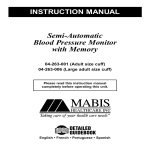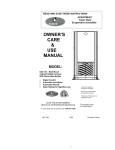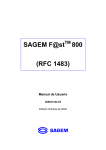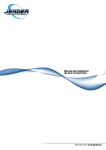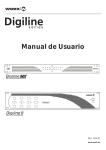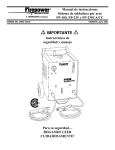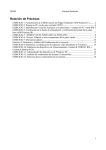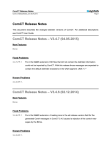Download Semi-Automatic Digital Blood Pressure Monitor with Memory
Transcript
INSTRUCTION MANUAL Semi-Automatic Digital Blood Pressure Monitor with Memory 04-267-001 (Adult size cuff) 04-267-006 (Large adult size cuff) Please read this instruction manual completely before operating this unit. English • Spanish Lifetime Limited Warranty Index This Blood Pressure Monitor is guaranteed to be free from manufacturing defects for the life of the original registered purchaser under normal use. This limited warranty does not apply to use in any clinical or commercial applications. If the unit fails to operate during the lifetime of the original registered purchaser, return it postage prepaid along with $5.00 for return shipping and insurance to: Repair Department, 1931 Norman Drive, Waukegan, IL 60085. If the warrantor determines that the unit failed to operate due to a manufacturing defect, the unit will be repaired or replaced at the option of the warrantor. Repair or replacement of the unit is the sole remedy under this limited warranty. This warranty gives you specific legal rights which vary from state to state. As a condition of this warranty, the enclosed warranty registration card must be completed and sent to us within 10 days of the purchase date. This Limited Warranty constitutes the warrantor’s only responsibility and obligation to repair and/or replace materials or components. We make no other express or implied warranties, arising by operation of law or otherwise, or any warranty of merchantability or fitness for a particular use or purpose whether or not the use or purpose has been disclosed to the warrantor in specifications, drawings or otherwise, and whether or not the warrantor’s products are specifically designed and/or manufactured by the warrantor for the buyer’s use or purposes, except for the limited warranty stated above. The warrantor will not be responsible for any indirect, incidental, special, consequential, or punitive damages or other loss, including, but not limited to, damage to or loss of other property or equipment and personal injuries, whether to purchaser or others. The warrantor shall in no event be liable to the purchaser for any amount in excess of the cost of repair and/or replacement of the unit. Introduction . . . . . . . . . . . . . . . . . . . . . . . . . . . . . . . . . . . . . . . . . . . . . . . . 2 Toll-Free Information Line: 1-800-622-4714 Sample Blood Pressure Log . . . . . . . . . . . . . . . . . . . . . . . . . . . . . . . . . . 19 Product Identification and Caution . . . . . . . . . . . . . . . . . . . . . . . . . . . . . . 3 General Blood Pressure Information . . . . . . . . . . . . . . . . . . . . . . . . . . . 4-6 Important Information Before Use . . . . . . . . . . . . . . . . . . . . . . . . . . . . . . 7 Battery Installation/Replacement . . . . . . . . . . . . . . . . . . . . . . . . . . . . . . . 8 Setting the Date/Time . . . . . . . . . . . . . . . . . . . . . . . . . . . . . . . . . . . . . . . . 9 Applying Your Blood Pressure Cuff . . . . . . . . . . . . . . . . . . . . . . . . . . 10-11 Taking Your Blood Pressure Reading . . . . . . . . . . . . . . . . . . . . . . . . 12-13 Recalling Measurements in Memory . . . . . . . . . . . . . . . . . . . . . . . . . . . 14 Description of Display Symbols . . . . . . . . . . . . . . . . . . . . . . . . . . . . . . . 15 Troubleshooting . . . . . . . . . . . . . . . . . . . . . . . . . . . . . . . . . . . . . . . . . . . 16 Error Codes . . . . . . . . . . . . . . . . . . . . . . . . . . . . . . . . . . . . . . . . . . . . . . 17 Care and Maintenance . . . . . . . . . . . . . . . . . . . . . . . . . . . . . . . . . . . . . . 17 Product Specifications . . . . . . . . . . . . . . . . . . . . . . . . . . . . . . . . . . . . . . 18 Blood Pressure Log . . . . . . . . . . . . . . . . . . . . . . . . . . . . . . . . . . . . . . . . 20 Manufactured by: MABIS Healthcare Inc. 1931 Norman Drive • Waukegan, IL 60085 847-680-6811 • FAX 847-680-9646 • www.mabis.net 1 Introduction Product Identification and Caution To achieve the maximum benefit from your blood pressure monitor, we recommend that you first consult with your physician or trained health care professional. Digital Display Thank you for purchasing a Digital Blood Pressure Monitor. With proper care and use, your monitor will provide you with many years of reliable readings. Cuff Jack The method of measurement that your Monitor uses is called the oscillometric method. The monitor detects your blood’s movement through the artery in your arm and converts the movements into a digital reading. The oscillometric method does not require a stethoscope, making the monitor easy-to-use. Blood pressure readings determined with this device are equivalent to measurements obtained by a trained observer using the cuff/stethoscope auscultation method, within the limits prescribed by the American National Standard for Electronic or Automated Sphygmomanometers. Time Set Button Battery Compartment POWER Arm cuff POWER Button Memory Button Tubing Connector Tubing Air Release Valve Inflation Bulb Caution While taking a measurement, you can stop the inflation or deflation process of the cuff at any time by pressing the POWER Button. 2 3 General Blood Pressure Information What is Blood Pressure? Blood pressure is the pressure that is exerted by blood flowing against the walls of the blood vessels throughout your body. Your heart, which is the center of the circulatory system, provides the force for the blood to flow or circulate. When your heart contracts or beats, the blood is forced through the blood vessels increasing the pressure. This is the highest pressure in the cycle or what is referred to as SYSTOLIC BLOOD PRESSURE. In between beats, your heart relaxes and your blood pressure decreases. This is referred to as DIASTOLIC BLOOD PRESSURE. This complete series of events which occurs in a single heartbeat is known as the CARDIAC CYCLE. Your Digital Blood Pressure Monitor will automatically read your blood pressure and display both systolic and diastolic readings on the screen. Your systolic will be positioned as the upper number and the diastolic reading will be the lower number. (systolic) 120 /80 (diastolic) Blood pressure is measured in millimeters (mm) of Mercury (Hg) and is generally recorded with the systolic pressure (120) listed first and the diastolic pressure (80) listed second. The numbers are typically separated by a slash mark ( / ) as shown above. Both pressure readings, the SYSTOLIC and the DIASTOLIC, are necessary for a physician to evaluate the status of a patient’s blood pressure. What Influences Blood Pressure? Many factors such as genetics, age, sex, altitude, physical activity, anxiety, muscular development, certain medications or even the time of day can influence blood pressure. Influences such as sleep or relaxation decreases blood pressure, while anxiety or exercise increases blood pressure. Why Monitor Your Blood Pressure at Home? A visit to a physician’s office can be a stressful situation for a patient. And, anxiety is a known factor in raising blood pressure. This temporary occurrence of elevated blood pressure at the physician’s office is commonly referred to as “white coat syndrome”. Whether or not you experience “white coat syndrome”, home blood pressure monitoring provides you with the opportunity to supplement your physician’s office measurements. These home readings, when taken over a period of time, can show an accurate indication of change. Furthermore, your records can assist your physician in evaluating your health and in making important decisions in the diagnosis and treatment of your condition. Because of this, it is important to take consistent, daily measurements of your blood pressure. The variations in your individual readings should only be interpreted by your physician or a trained health care professional. WHO Blood Pressure Classifications Standards for assessment of high or low blood pressure, regardless of age, have been established by the World Health Organization (WHO) as shown in the chart on the following page. Please contact your physician for specific information regarding your own blood pressure. 4 5 CATEGORY SYSTOLIC (mmHg) DIASTOLIC (mmHg) <120 <130 130-139 140-159 140-149 160-179 ≥180 <80 <85 85-89 90-99 90-94 100-109 ≥110 ≥140 140-149 <90 <90 Optimal Normal High - Normal Mild Hypertension Borderline Moderate Hypertension Severe Hypertension Isolated Systolic Hypertension Borderline This chart is only a general guideline. Please contact your physician to determine your NORMAL BLOOD PRESSURE. Important Information Before Use 1. Blood pressure measurements should only be interpreted by a physician or a trained health care professional who is familiar with your medical history. Through regular use of this device and recording of your measurements, you can keep your physician informed of the changes in your blood pressure. 2. Perform your measurement in a quite place. You should be seated in a relaxed position. 3. Avoid smoking, eating, taking medication, alcohol consumption or physical activity 30 minutes prior to taking a reading. If you are exhibiting signs of stress, avoid taking your measurement until the feeling subsides. 4. Rest 15 minutes prior to taking a reading. 5. Remove any constrictive clothing or jewelry that may interfere with the cuff placement. Variations in Blood Pressure Blood Pressure (mmHg) Blood pressure can be influenced by many factors. This change can occur from moment to moment. Normally, blood pressure is lowest during the sleeping period and rises during the day. The graph below represents the variations in blood pressure shown over a day with measurements taken every 5 minutes. sleep I I I I I I I I I I I I I I I I I I I I I I I I 12 1 2 3 4 5 6 7 8 9 10 11 12 1 2 3 4 5 6 7 8 9 10 11 PM Time AM 6 The dotted line represents the sleep period. The rise in blood pressure at 1 PM (A in the graph) corresponds to a stressful occurrence and at 7 PM (B in the graph) a period of exercise. 6. Keep the monitor stable during measurements. Remain still; do not talk during measurements. 7. Record your daily blood pressure and pulse readings on a chart. 8. Take your readings at the same time, each day (or as recommended by your physician) to get an accurate indication of change in your true blood pressure. 9. Wait a minimum of 15 minutes between readings to allow for the blood vessels to return to normal. The wait time may vary depending on your individual physiological characteristics. 10. This device is intended for adult use. While taking a measurement, you can stop the inflation or deflation process of the cuff at any time by pressing the POWER Button. 7 Battery Installation/Replacement Setting the Date/Time 1. Press the Time Set Button to enter into the Time Adjustment mode. The blinking Month will display, Fig. 1. Replace the batteries when the Low Battery symbol appears on the display, Fig. 1, or when the display remains blank when the POWER Button is pressed. 2. Press the ‘M’ Button to change. To change the batteries: 3. Press the Time Set Button 1. Open the battery cover off, Fig. 2. 4. The blinking Date, Fig. 2, followed by Year, Hour and Minutes will display. Repeat steps 2 and 3 to adjust the date/time setting. 2. Making sure the battery polarity is correct, install four AA alkaline batteries, Fig. 3. 3. Close the battery cover, Fig. 4. to confirm entry. Fig. 1 NOTE: It is recommended to remove the batteries if the unit will not be used for an extended period of time. Fig. 1 5. Your unit is now ready to take a reading, or press the Start Button to turn the unit off, Fig. 3. Press the Button Fig. 2 blinking Month changing Month Fig. 2 Fig. 3 Fig. 4 confirm the entry Fig. 3 8 9 Applying Your Blood Pressure Cuff Avoid smoking, eating, taking medication, alcohol consumption or physical activity 30 minutes prior to taking a reading. If you are exhibiting signs of stress, avoid taking your measurement until the feeling subsides. Rest 15 minutes prior to taking a reading. NOTE: If for any reason you are unable to or should not use your left arm, please modify the following instructions and apply the cuff to your right arm. Your physician can tell you which arm is best for you to use. 1. Remove any constrictive clothing or jewelry that may interfere with the cuff placement. 6. The bottom edge of the cuff should be positioned approximately one inch ABOVE the elbow joint, Fig. 3. 7. Reaching underneath your left arm with your right hand, pull the end of the cuff towards your body to tighten the cuff, Fig. 4. Wrap and secure the cuff making sure that the ( ) mark remains as shown, Fig. 2. 8. The cuff should fit comfortably, yet snugly around your arm. You should be able to insert one finger between your arm and the cuff. Fig. 4 2. Be seated with your feet flat on the floor. 5. Insert your left arm into the cuff (cylinder). Position the ( ) mark over the main artery (on the inside of your arm), Fig. 2. NOTE: The cuff size is suitable for use when the vertical ‘index’ mark is within the horizontal ‘OK’ range. A different sized cuff is needed if the ‘index’ mark is outside the ‘OK’ range. IN D E X 3. Position the cuff on a solid surface with the tubing facing UP and AWAY from you. The metal bar on the cuff should be to the left of the tubing. 4. Widen or open the cuff by pulling or rolling the bottom of the cuff towards the right, Fig. 1. This should open the cuff, creating a cylinder. Do not extend the cuff beyond the metal bar. Fig. 1 Fig. 2 10 Fig. 3 11 Taking Your Blood Pressure Reading Proceed only after reading the previous sections of this manual. Remember! Remain still; do not talk during the measurement. 1 Position the monitor on a flat, stable surface with the digital display in view. Insert the cuff tubing connector into the left side of the monitor, Fig. 1. 2. Rest your (left) elbow on a solid surface with your palm facing upward. Elevate your arm so that the cuff is at the same level as your heart, Fig. 2. Relax your (left) hand. Fig. 4 12 Fig. 6 9. Press the air release valve until the cuff pressure is released. Fig. 1 10. Your reading will be automatically stored in memory. Systolic 11. To conserve energy, press the POWER Button to turn the unit off. Otherwise, the unit will automatically shut off after approximately 2 minutes. 4. After the self-test, the last reading will briefly appear on the display, Fig. 4. Fig. 3 7. The pressure in the cuff will automatically begin to decrease. The display will represent the deflation, Fig. 6. 8. Upon completion, your blood pressure (systolic and diastolic) measurement and pulse reading will display, Fig. 7. 3. Press the POWER Button. The unit will run a self-test, Fig. 3. 5. Using your right hand, squeeze and release the inflation bulb at a steady pace. The inflation pressure must be approximately 30 mmHg above your normal systolic pressure. Continue to steadily inflate the cuff to the sufficient level, Fig. 5. 6. Upon achieving the proper inflation level, release the pressure on the bulb. Diastolic Pulse Fig. 7 Fig. 2 12. Disconnect the cuff tubing from the monitor prior to storing. Fig. 5 13 Recalling Measurements in Memory You can recall up to 60 measurements plus an average of all currently stored measurements in memory to share with your physician or trained healthcare professional. 1. Press the ‘M’ Button. The first reading displayed is the average of all measurements stored in memory. The letters ‘AVG’ will appear on the display, Fig. 1. Description of Display Symbols SYMBOL CONDITION ACTION Appears when pulse reading is displayed. Record pulse reading. Appears when recalling a measurement from memory. Memory recall function in progress. Appears when battery voltage is excessively low. Replace batteries with new ones. Appears when manual cuff inflation is needed. Measurement in progress. Appears when manual cuff deflation is needed. Measurement in progress. 2. Continue to press the ‘M’ Button to view the next previously stored measurement, Figs. 2-3. NOTE: The memory bank can store up to 60 readings. When the number of readings exceeds 60, the oldest data will be replaced with the new record. Fig. 1 Fig. 2 Fig. 3 14 15 Error Codes Troubleshooting If any abnormality occurs during use, please check and correct the following: Err 0 No pulse is detected Err 1 Inflation rate is too low Condition Correction Err 2 Systolic reading unattainable Err 3 Cuff pressure is too high Display is blank when power is on. Check and correct the polarity of the installed batteries. Reinstall or replace batteries. Err 4 Diastolic pressure is outside of operation range Err 5 Cuff deflated too fast Err 6 Cuff deflated too slow Err 7 Systolic pressure is outside of operation range Err 8 Overall pressure is outside of operation range Err 9 Cuff is unable to inflate to the necessary pressure level Measurement incomplete or abnormally low or high values displayed. Review and follow ‘Applying Your Blood Pressure Cuff’ and ‘Taking Your Blood Pressure Reading’ sections. Replace the batteries. Measurements are different from those typically measured by physician or every measurement reading is different. Remember, blood pressure readings are influenced by physical and mental conditions and/or even the time of day. Daily measurement recordings should be interpreted by your physician. 16 Care and Maintenance 1. 2. 3. 4. Disconnect the cuff tubing from the monitor prior to storing. Only use a soft, dry cloth to clean your blood pressure monitor. Avoid using any types of liquids on the monitor or cuff. Do not store the unit where it will be exposed to direct sunlight, dust or humidity. 5. Avoid extreme temperatures. 6. Never disassemble the monitor or cuff. 7. Dropping or subjecting your blood pressure monitor to strong shocks should be avoided. 17 Product Specifications Name and Model Number Display System Measuring Method Power Source Measuring Range Accuracy Inflation Deflation Memory Automatic Power Off Battery Life Operation Temperature Humidity Storage Temperature Humidity Weight Dimensions Arm Circumference Range Accessories Options (sold separately) Sample Blood Pressure Log MABIS Semi-Automatic Digital Blood Pressure Monitor, 04-267-001, 04-267-006 Digital display/LCD Oscillometric 4 AA batteries Pressure: 30 to 280 mmHg Pulse: 40-200 beats/minute Pressure: ±3 mmHg Pulse: ±4% of reading Manual inflation Automatic pressure release valve Built-in memory enabling display of up to 60 measurements plus average of all currently stored measurements Approximately 2 minutes after last button operation Approximately 300 measurements 50°F – 104°F (10°C – 40°C) 15% to 95% RH (non-condensing) -4°F – 122°F (-20°C – 50°C) 15% to 95% RH (non-condensing) 9.2 oz. (without batteries) 5-1/2” x 5” x 2-1/2” Adult size fits arm circumference: 9” x 13” (23-33 cm) Large adult size fits arm circumference: 13” x 17” (33-43 cm) Cuff, detailed guidebook, four AA batteries Quick Start Guides Adult size cuff, Large Adult size cuff Specifications are subject to change without notice. 18 #91-032-267 08/04 ©2004 MABIS Healthcare Inc. 19 Blood Pressure Log Name: Age: MANUAL DE INSTRUCCIONES Weight: Date Monitor Semiautomático con Memoria para Presión Arterial Time mmHg 240 220 200 180 04-267-001 (Brazalete tamaño adulto) 04-267-006 (Brazalete tamaño adulto grande) 160 140 Sírvase leer toda esta guía antes de operar la unidad. 120 100 80 60 Pulse Body Condition Inglés • Español 20 Garantia Limitada Vitalicia Índice Este Monitor de Presión Arterial tiene garantía contra defectos de fabricación durante la vida del comprador registrado original, en condiciones de uso normal. La garantía limitada no se aplica al uso en cualquier aplicación clínica o comercial. Si la unidad no funciona durante la vida del comprador registrado original, devuélvala previamente pagada junto con $5,00.- en concepto de gastos de envío y seguro a: Departamento de Reparaciones, 1931 Norman Drive, Waukegan, IL 60085. Si el garante determina que se trata de un defecto de fabricación, se reparará o sustituirá la unidad, a opción de esta. La reparación o reemplazo de la unidad es el único recurso que otorga esta garantía limitada. Esta garantía le otorga derechos legales específicos, que varían de un estado a otro. Como condición de la presente garantía, se deberá completar la tarjeta adjunta de registro de la garantía y enviarla a nuestras oficinas dentro de los 10 días de la fecha de compra. Introducción . . . . . . . . . . . . . . . . . . . . . . . . . . . . . . . . . . . . . . . . . . . . . . 24 Esta Garantía Limitada constituye la única responsabilidad y obligación del garante de reparar y/o cambiar materiales o componentes. No otorgamos otras garantías expresas o implícitas, que surjan de la operación de la ley o de otra manera, o cualquier garantía de comerciabilidad o adaptabilidad para un uso o propósito específico, ya fuera o no que el uso o propósito hubiese sido divulgado al garante en especificaciones, dibujo o de otra manera, y ya fuera o no que los productos del garante hubiesen sido específicamente diseñados y/o fabricados por el garante para el uso o propósito del comprador, excepto por la garantía limitada indicada anteriormente. El garante no será responsable por los daños indirectos, incidentales, especiales, consecuentes o punitivos, u otras pérdidas, incluyendo, sin limitación, daños o pérdidas de otros bienes o equipos y lesiones personales, ya sea al comprador o a otros. El garante no será de ninguna manera responsable frente al comprador por cualquier monto que supere el costo de reparación y/o cambio de la unidad. Línea Gratuita de Atención al Cliente 1-800-622-4714 Fabricado por: MABIS Healthcare Inc. 1931 Norman Drive • Waukegan, IL 60085 847-680-6811 • FAX 847-680-9646 • www.mabis.net Indentificación del Producto y Precaución . . . . . . . . . . . . . . . . . . . . . . . 25 Información General Acerca de la Presión Arterial . . . . . . . . . . . . . . 26-28 Información Importante Previo al Uso . . . . . . . . . . . . . . . . . . . . . . . . . . 29 Colocación/Cambio de Baterías . . . . . . . . . . . . . . . . . . . . . . . . . . . . . . . 30 Cómo Colocar la Fecha/Hora . . . . . . . . . . . . . . . . . . . . . . . . . . . . . . . . . 31 Cómo Colocar el Brazalete de Presión Arterial . . . . . . . . . . . . . . . . 32-33 Cómo Tomar la Lectura de la Presión Arterial . . . . . . . . . . . . . . . . . 34-35 Cómo Llamar Mediciones de la Memoría . . . . . . . . . . . . . . . . . . . . . . . 36 Descripción de los Símbolos del Visor . . . . . . . . . . . . . . . . . . . . . . . . . . 37 Análisis de Fallas . . . . . . . . . . . . . . . . . . . . . . . . . . . . . . . . . . . . . . . . . . 38 Códigos de Error . . . . . . . . . . . . . . . . . . . . . . . . . . . . . . . . . . . . . . . . . . 39 Cuidado y Mantenimiento . . . . . . . . . . . . . . . . . . . . . . . . . . . . . . . . . . . . 39 Especificaciones del Producto . . . . . . . . . . . . . . . . . . . . . . . . . . . . . . . . 40 Ejemplo de Registro de Preción Arterial . . . . . . . . . . . . . . . . . . . . . . . . 41 Registro de Preción Arterial . . . . . . . . . . . . . . . . . . . . . . . . . . . . . . . . . . 42 23 Introducción Identificación del Producto y Precaución Para obtener el máximo beneficio del monitor de presión arterial, se recomienda consultar primero con el médico o profesional capacitado del área de salud. Visor Digital Gracias por comprar un Monitor Digital de Presión Arterial. Con el debido cuidado y uso, obtendrá lecturas confiables durante muchos años. Soporte del brazalete El método de medición que emplea el Monitor se denomina oscilométrico. El monitor detecta el movimiento de la sangre por la arteria del brazo y lo convierte en lectura digital. El método oscilométrico no requiere del uso de un estetoscopio; por lo que el onitor resulta fácil de usar. Las lecturas de presión arterial determinadas con este dispositivo equivalen a las obtenidas por un observador capacitado que emplee el método de auscultación con brazalete/estetoscopio, dentro de los límites prescritos por la American National Standard for Electronic or Automated Sphygmomanometers (Norma Nacional Estadounidense de Esfigmomanómetros Electrónicos o Automatizados). Brazalete para el Brazo Compartimiento de las Baterías POWER Botón para Configurar la Hora Botón para POWER Botón para Llamar la Memoria Conector del Tubo Tubo Botón de la válvula de seguridad Bomba de inflado Precaución Mientras toma una medición, puede detener el proceso de inflado o desinflado del brazalete en cualquier momento con sólo pulsar el Botón de POWER. 24 25 Información General Acerca de la Preción Arterial ¿Qué es la presión arterial? La presión arterial es la que ejerce la sangre al fluir por las paredes de los vasos sanguíneos del organismo. El corazón, centro del sistema circulatorio, ofrece la fuerza para que la sangre fluya o circule. Cuando se contrae o late, la sangre se impulsa a través de los vasos sanguíneos y aumenta la presión. Esta es la presión más alta en el ciclo o la denominada PRESIÓN ARTERIAL SISTÓLICA. Entre cada latido, el corazón se relaja y la presión arterial disminuye; lo cual se conoce con el nombre de PRESIÓN ARTERIAL DIASTÓLICA. Esta serie completa de eventos que tiene lugar en un solo latido del corazón se denomina CICLO CARDÍACO. El Monitor Automático MABIS leerá automáticamente su presión arterial y mostrará las lecturas sistólica y diastólica en la pantalla. La presión sistólica estará indicada por el número superior y la diastólica, por el inferior. (sistólica) 120 /80 (diastólica) La presión arterial se mide en milímetros (mm) de mercurio (Hg) y, por lo general, al registrarla, se indica primero la presión sistólica (120) y la diastólica (80) después. Típicamente, los números están separados por una barra ( / ) según se indica más arriba. Ambas lecturas, la SISTÓLICA y la DIASTÓLICA, son necesarias para que un médico pueda evaluar el estado de la presión arterial de un paciente. Póngase en contacto con su médico para recibir información específica acerca de su presión arterial. 26 ¿Qué influye en la presión arterial? Muchos factores relacionados con la genética, edad, sexo, altitud, actividad física, ansiedad, desarrollo muscular, ciertos medicamentos e incluso el momento del día pueden influir en la presión arterial. Factores como el dormir y la relajación disminuyen la presión arterial, mientras que la ansiedad o el ejercicio físico la aumentan. Por Qué Controlar la Presión Arterial en Hogar? La visita al consultorio de un médico puede resultar estresante para un paciente. Y, la ansiedad, es un factor que, se sabe, eleva la presión arterial. Esta situación temporal de presión arterial elevada en e consultorio del médico se conoce comúnmente con el nombre de ‘síndrome del delantal blanco’. Experimente o no dicho síndrome, el control de la presión arterial en el hogar le brinda la oportunidad de complementar las mediciones realizadas en el consultorio del médico. Cuando dichas lecturas en el hogar se toman durante un período de tiempo, pueden indicar un cambio preciso. Asimismo, sus registros pueden serle de utilidad a su médico en la evaluación de la salud y en la toma de importantes decisiones en cuanto al diagnóstico y tratamiento de su condición. Debido a ello, es importante tomar mediciones diarias y consistentes de la presión arterial. Las variaciones en las lecturas individuales sólo debe interpretarlas su médico o un profesional capacitado del área de salud. OMS (Organización Mundial de la Salud) Clasificaciones de la Presión Arterial La Organización Mundial de la Salud (OMS) ha establecido normas para la evalución de la presión arterial baja or alta, independientemente de la edad, según se indica en el siguiente diagrama: 27 CATEGORIA SISTÓLICA (mmHg) DIASTÓLICA (mmHg) Optima Normal Alto - Normal Hipertensión leve En el límite Hipertensión moderada Hipertensión grave <120 <130 130-139 140-159 140-149 160-179 ≥180 <80 <85 85-89 90-99 90-94 100-109 ≥110 Hipertensión Sistólica Aislada En el límite ≥140 140-149 <90 <90 Este cuadro es sólo una guía general. Consulte a su médico o profesional capacitado en el campo de la salud para determinar su presión arterial NORMAL. Información Importante Previo al Uso 1. Las mediciones de la presión arterial sólo debe interpretarlas un médico o profesional capacitado del área de salud familiarizado con su historia clínica. Con el uso periódico de este dispositivo y el registro de las mediciones, podrá mantener informado al médico de los cambios registrados en su presión arterial. 2. Tome las mediciones en un lugar tranquilo. Debe estar sentado y relajado. 3. Evite fumar, comer, tomar medicamentos, el consumo de alcohol o la actividad física 30 minutos antes de la lectura. Si evidencia signos de estrés, evite tomarse la presión mientras esa sensación no haya desaparecido. 4. Descanse 15 minutos antes de tomar una lectura. 5. Retire toda indumentaria o accesorio apretado que pudiere interferir con la colocación del brazalete. Variaciones de la Preción Arterial Muchos factores influyen en la presión arterial y puede variar de un momento a otro. Normalmente, la presión arterial es más baja durante el sueño y se eleva durante el día. El gráfico a continuación representa las variaciones de la presión arterial durante el día con mediciones tomadas cada 5 minutos. La línea de puntos representa el período de sueño. El aumento de la presión arterial a la 1 p.m. (A en el gráfico) corresponde a un hecho estresante y a las 7 p.m. (B en el gráfico) a un período de ejercicios físicos. 28 6. Mantenga el monitor estable durante la medición para lograr una lectura precisa. Permanezca quieto; no hable durante la medición. 7. Registre en una planilla las lecturas diarias de presión arterial y pulso. 8. Tome las lecturas todos los días a la misma hora (o según lo recomendado por el médico) a fin de obtener una indicación precisa del cambio en la presión arterial real. 9. Espere, como mínimo, 15 minutos entre lecturas a fin de permitir que los vasos sanguíneos regresen a su condición normal. El tiempo de espera puede variar; lo cual dependerá de las características fisiológicas individuales. 10. Este dispositivo ha sido diseñado para uso en adultos. Se puede detener el proceso de inflado y desinflado con sólo pulsar el Botón de POWER. 29 Colocación/Cambio de Baterías Cómo Colocar la Fecha/Hora Cambie las baterías cuando aparezca el símbolo de Poca Batería en el visor, Fig. 1, o cuando el visor permanezca en blanco al presionar el Botón de POWER. 1. Presione el Botón para Configurar la Hora para ingresar en el modo Ajuste de la Hora. Aparecerá Mes en forma intermitente, Fig. 1. 2. Presione el Botón ‘M’ para cambiar. Para cambiar las baterías: 3. Presione el Botón para Configurar la Hora y confirmar la información ingresada, Fig. 2. 1. Abra la tapa del compartimiento de las baterías, Fig. 2. 2. Asegúrese de que la polaridad de las baterías sea la correcta y luego coloque cuatro baterías AA alcalinas, Fig. 3. 4. Aparecerá la Fecha, en forma intermitente, seguida por el Año, la Hora y los Minutos. Repita los pasos 2 y 3 para ajustar la fech y/o la hora. Fig. 1 3. Cierre la tapa del compartimiento de las baterías, Fig. 4. NOTA: Recomendamos quitar las baterías si la unidad permanecerá fuera de funcionamiento durante un prolongado período. Fig. 1 5. Su unidad ahora está lista para hacer una lecturea, de lo contrario presione POWER para, apagar la unidad, Fig. 3. Presione Botón Fig. 2 mes titilando cambiar mes Fig. 2 Fig. 3 Fig. 4 confirmar el ingreso Fig. 3 30 31 Cómo Colocar el Brazalete de Presión Arterial Evita fumar, comer, tomer medicamentos, el consume de alcohol o la actividad física 30 minutos antes de la lectura. Si evidencia signos de estrés, evite tomarse la presión mientras esa sensaciónno haya desaparecido. NOTA: Si por algún motivo no puede o no debe usar su brazo izquierdo, modifique las siguientes instrucciones y coloque el brazalete en so brazo derecha. Su médico puede decirle qué brazo debe usar. 6. El borde inferior del brazalete debería colocarse aproximadamente una pulgada por ARRIBA del codo, Fig. 3. 7. Con la mano derecha yendo por debajo, tome el brazo izquierdo y estire el extremo del brazalete hacia usted para ajustar el brazalete, Fig. 4. Enrolle de manera segura el brazalete, verificando que el signo ( ) permanezca como se muestra el la Fig. 2. Fig. 3 2. Siéntese con los pies apoyados sobre el piso. 8. El brazalete debe calza cómodamente pero ajustado alrededor del brazo y no debe incomodar. Tiene que poder insertar un dedo entre el brazo y el brazalete. 3. Apoye el brazalete sobre una superficie sólida con el tube mirando hacia ARRIBA y LEJOS suyo. Esto debería abrir el brazalete, creando un cilindro. NOTA: El tamaño del brazalete es el adecuado cuando el signo ‘index’ vertical esté dentro del rango horizontal ‘OK’. Se necesita un tamaño diferente de brazalete si el signo ‘index’ queda fuera del rango ‘OK’. E D IN 4. Agrande o abra el brazalete extendiendo o enrollando la parte inferior del brazalete hacia la derecha. Esto debería abrir el brazalete, creando un cilindro. Esto debería abrir el brazalete, creando un cilindro. No extienda el brazalete más allá de la barra de metal, Fig. 1. X 1. Quite cualquier ropa o joyas ajustadas que puedan interferir con la colocación del brazalete. Fig. 1 5. Inserte el brazo en el brazalete (cilindro). Coloque el signo ( ) sobre la arteria pricipal (en el parte interna del brazo), Fig. 2. Fig. 2 32 33 Fig. 4 Cómo Tomar la Lectura de la Presión Arterial Proceda luego de haber leído las secciones anteriores de este manual. ¡Recuerde! Permanezca inmóvil; no hable durante la medición. 1. Coloque el monitor sobre una superficie plana y estable con el panel del visor digital a la vista. Inserte el conector del tubo del brazalete en el lado izquierdo del monitor, Fig. 1. 2. Apoye el codo (izquierdo) sobre un superficie sólida con la palma mirando hacia arriba. Eleve el brazo de manera que el brazalete quede al mismo nivel del corazón, Fig. 2. Relaje la mano (izquierda). Fig. 1 5. Con la mano derecha presione y suelte la bomba Fig. 2 de inflado a un ritmo constante. La presión de inflado debe ser aproximadamente 30 mmHg superior a su presión sistólica normal. Continúe inflando el brazalete a un ritmo constante 34 7. La presión en el brazalete comenzará a disminuir automáticamente. El visor mostrará el desinflado, Fig. 6. Fig. 6 9. Presione la válvala del langamiento de aire hasta que la presión de la brazalete este langamiento. Sistólica 10. Las lectura se guardará en la memoria automáticamente. 4. Una vez realizada la prueba automática, aparecere la última lectura en la pantalla, Fig. 4. Fig. 4 6. Una vez alcanzado el nivel de inflado adecuado, libere la presión de la bomba. 8. La unidad mostrará la medición de la presión arterial (sistólica y diastólica) y las pulsaciones, Fig. 7. 3. Presione el Botón de POWER. La unidad hará un autoexamen, Fig. 3. Fig. 3 hasta alcazar el nivel adecuado, Fig. 5. 11. Para conservar energía, presione el Botón POWER para apagar la unidad. De lo contrario, la unidad se apagará automáticamente después de alrededor de 2 minutos. Diastólica Pulsaciones Fig. 7 12. Desconecte el tubo del brazalete del monitor antes de guardar la unidad. Fig. 5 35 Cómo Llamar las Mediciones de la Memoria Puede llamar hasta 60 lecturas totales y también el promedio de todas las lecturas grabadas en la memoria para registrar en un Diario de la Presión Arterial o para que pueda informarle a su médico o prefesional de la salud calificado. 1. Presione el Botón ‘M’. La primera lectura que aparece es el promedio de todas las mediciones almacenadas en la memoria. Las letras ‘AVG’ aparecerán en la pantalla, Fig. 1. 2. Continúe presionando el Botón ‘M’ para ver la siguiente medición grabada, Figs. 2-3. Fig. 1 NOTA: El banco de memoria puede almacenar hasta 60 lecturas. Cuando la cantidad de lecturas supera las 60, los datos más antiguos serán reemplazados con el nuevo registro. Descripción de los Símbolos del Visor SÍMBOLO CONDICIÓN ACCIÓN Aparece cuando se muestra la lectura del pulso. Grabe la lectura del pulso. Aparece cuando se llama una medida de la memoria. Función de llamado de la memoria en curso. Aparece cuando el voltaje de la baterías es demaslado bajo. Coloque baterías nuevas. Aparece cuando es necesario inflar el brazalete en forma manual. Medición en curso. Aparece cuando es necesario desinflar el brazalete en forma manual. Medición en curso. Fig. 2 Fig. 3 36 37 Códigos de Error Análisis de Fallas Si ocurriera una anomalía durante el use, verifique y corrija lo siguiente: Condición Corrección El visor está en blanco cuando el botón de encendido está prendido. Revise y corrija la polaridad de las baterías. Vuelva a colocar o cambie las baterías. Medición incompleta o aparecen valores anormalmente altos o bajos. Las medicciones son diferentes de las mediciones usuales que realiza el médico o cada lectura de medición es diferente. Revise y siga las secciones ‘Cómo Colocar el Brazalete de Presión Arterial’ y ‘Cómo Tomar una Lectura de Presión Arterial.’ Cambie las baterías. Recuerde que las condiciones mentales y físicas y/o el momento del día influyen en las lecturas de la presión arterial. Su médico es quien debe interpretar las mediciones diarias. 38 Err 0 No se detectó el pulso Err 1 El nivel de inflación es demasiado bajo Err 2 No se puede obtener la lectura sistólica Err 3 La presión del brazalete es demasiado alta Err 4 La presión diastólica está fuera del rango de operación Err 5 El brazalete se desinfló demasiado rápido Err 6 El brazalete se desinfló demasiado despacio Err 7 La presión sistólica está fuera del rango de operación Err 8 La presión en general está fuera del rango de operación Err 9 El brazalete no puede inflarse para alcanzar el nivel necesario de presión Cuidado y Mantenimiento 1. Desconecte el tubo del brazalete del monitor ante de guardar la unidad. 2. Usa solamente un paño seco y suave para limpiar el monitor de presión arterial. 3. Evite usar cualquier tipo de líquido en el monitor o brazalete. 4. No guarde la unidad donde esté expuesta a la luz directa del sol, polvo o humedad. 5. Evite las temperaturas extremas. 6. Nunca desarme el monitor or brazalete. 7. Evite que se caiga o golpe el monitor de presión arterial. 39 Especificaciones del Producto Nombre y Número de Modelo Tipo de Visor Método de Medición Fuente de Energía Alcance de la Medición Precisión Presurización Desinflado Memoria Apagado Automático Vida Útil de las Baterías Operación Temperatura Humedad Almacenamiento Temperatura Humedad Peso Dimensiones Rango de Circunferencia del Brazo Accesorios Opciones (se venden por separado) Ejemplo de Registro de Preción Arterial MABIS Monitor Semiautomático Digital para Presión Arterial con Memoria, 04-267-001, 04-267-006 Visor digital/LCD Oscilométrico 4 baterías tipo AA Presión: 30 a 280 mmHg Pulso: 40-200 pulsaciones/minuto Presión: ± 3 mmHg, Pulso: ±4% de la lectura El inflado manuelle Válvula de descarga de presión automática 60 lectura y el promedio de todas las lecturas grabadad en la memoria Aproximadamente 2 minutos después de la última operación importante Aproximadamente 300 mediciones 50°F – 104°F (10°C – 40°C) 15% a 95% RH máx. -4°F – 122°F (-20°C – 50°C) 15% a 95% RH máx. 9.2 oz. (sin baterías) 5-1/2” x 5” x 2-1/2” El tamaño adulto es adecuado para la circunferencia del brazo: 9” – 13” (23-33 cm) El tamaño adulto grande es adecuado para la circunferencia del brazo: 13” – 17” (33-43 cm) Brazalete, guía detallada, cuatro baterías AA, Guías para un Inicio Rápido Brazalete tamaño adulto, brazalete tamaño adulto grande Las especificaciones están sujetas a cambios sin previo aviso. 40 #91-032-267 08/04 ©2004 MABIS Healthcare Inc. 41 Registro de Presión Arterial 42

























